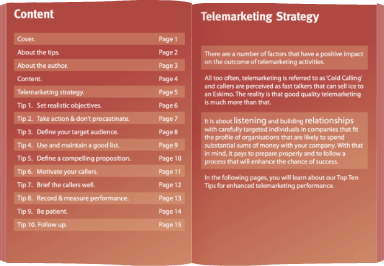Lead generation for new business is tough. Sadly, in most cases, prospects aren’t rushing to buy what you provide. Unless you’re a big player in your industry, they may not even be aware of what you do. And, they may just not be in the market at the very moment when you need an uplift in sales.
Quick fixes are rare. Low hanging fruit may not exist. These concepts are somewhat of a fallacy. Valuable business development usually takes time and effort. Successful sales development activity rarely comes cheap. Whether you rely on in-house resourcing, or you outsource, a clear strategy for business development is crucial. Flying by the seat of one’s pants isn’t generally a good option.
This blog takes a look at ten elements that we feel are essential to develop your sales pipeline, empowering directors of SMEs to build successful lead generation campaigns and to achieve tangible results.
Profiling and Segmenting Your Audience:
It would be wonderful if everyone had a plan. Yet, sometimes, a business just evolves. In other words, it may have started with an idea, and that idea resulted in a direction that, over time, has taken a few twists and turns. Clients may have been, and continue to be, diverse. There may not have been a pattern or clarity of purpose.
Yet, before launching any marketing outreach, truly understanding and profiling and segmenting your audience is a significant early task. Who is your primary target audience? Where does your product or service sit most comfortably? Is there a clear reason why a purchaser in a certain area would buy from your company?
Perhaps you can sell to anyone. But, would every company benefit from transacting with you? Which are those that would benefit most, and that are more likely, than others, to be in the market?
By segmenting via demographics, but also by preferences, and pain points, you can tailor your messaging to better resonate with your target market. Research by HubSpot underscores the power of personalisation, with personalised emails boasting a 14% higher click-through rate and a 10% increase in conversion rates. The same principle applies to other channels. The more ‘vanilla’ and commoditised your approach, the less likely you are to succeed.
Therefore, a more data-driven approach ensures that you focus on businesses, and decision-makers, that are more likely to need what you offer. This improves the likelihood that every interaction with your prospects is more relevant, laying the groundwork for a successful sales strategy.
Understanding Your Client’s Needs and Pains:
Effective marketing outreach usually benefits from a good understanding of client’s needs and especially their challenges and pains. Having a good appreciation of likely market triggers that influence purchases, is paramount.
Try to uncover prospective challenges and aspirations that your company can address. Ask your current customers if you’re unsure. Do some research. The reality is that those who are in the market for your products or services are there for a reason. Buyers don’t buy randomly. Something prompts them to start making enquiries. What is that factor in your business? Do you understand why customers buy?
If you can align your business, and your primary proposition, with the reason why buyers are in the market, you’ll be more able to demonstrate why you’re the perfect partner.
According to Salesforce, up to 86% of buyers are willing to pay more for a great customer experience. By positioning your organisation, as a trusted advisor and problem solver, through evidence of catering to customer needs, you can cultivate trust and credibility, paving the way for enduring partnerships.
Carry that through in messaging across all of your marketing channels, in your content, and on website service pages, and you’re more likely to encourage inbound leads. What’s more, your proactive outreach will be more compelling.
Identifying a Target Database:
One of the main pillars of successful outreach is the identification of a precise target database, or marketing target list. By researching and compiling data on potential leads, SMEs can ensure that their efforts are directed towards the most promising prospects. Utilising advanced analytics tools and market research, businesses can segment their databases based on factors such as industry, company size, decision-maker role, and purchasing behaviour.
According to a study by Aberdeen Group, organisations with a well-defined target database experience a 7.8% annual increase in revenue, highlighting the crucial role of targeting in driving business growth. With a robust database in hand, companies can better execute targeted outbound marketing campaigns that yield high-quality leads and tangible results.
There are so many platforms and tools available. No data is perfect. But, better data is essential. There’s no panacea. Artificial Intelligence is helping. But, even tools such as Sales Navigator, which individuals complete, and update, themselves, are far from perfect. So, it’s a constant challenge, and ongoing data management is usually required.
Blending Push and Pull Strategies:
Demand generation and proactive lead generation are likely bedfellows when it comes to a business development strategy that works. Some businesses are in the extremely fortunate position where they’re well-known, perhaps specialists in their field, and new business finds them rather than the reverse. However, that’s not the norm. Some blend of push and pull is necessary.
An integrated strategy is preferable. Warming up potential leads, and encouraging them onto a landing page with a strong call to action is ideal. Whether the start point is SEO, PPC, sponsored content, Email marketing, a well-drafted thought piece, or a webinar on a hot topic, stimulating inbound enquiries makes them warmer, and more likely to convert.
While traditional B2B outbound calling remains a cornerstone of business development, complementing it with inbound marketing strategies enhances effectiveness. By creating compelling content, such as blog posts, whitepapers, and webinars, companies can attract prospects to their website and nurture them through the sales funnel. Research by Content Marketing Institute reveals that businesses with blogs generate 67% more leads than those without. By seamlessly integrating push and pull strategies, time-poor business developers can increase the likelihood of success in their lead generation efforts.
Creating Interest through Content:
It’s an overused expression, and it’s perhaps less true nowadays than in the past, due to the amount of clutter we all see all the time, but content is king. Thought leadership reigns supreme in capturing the attention of potential leads. If you can establish your business as an industry authority, by consistently producing and disseminating high-quality content that addresses the pain points and challenges of your target audience, you’re on the right track.
Whether through informative blog posts, insightful case studies, or engaging video and social media updates, businesses can position themselves as a valuable resource for prospects seeking solutions. According to Demand Metric, content marketing generates three times as many leads as traditional outbound marketing, underscoring its pivotal role in driving lead generation success. But, once again, it’s not a quick fix. We’ve been producing content for more than a decade! We have over 500 pieces of content on our website. That’s why Google likes GSA Business Development.
By including content development and distribution in your strategy, even smaller SMEs can cultivate interest, build brand credibility, and ultimately, stimulate and convert leads into customers. It doesn’t have to be complicated. There are plenty of tools out there to help with the content distribution. And, if you’re no Shakespeare, there are content writers on various platforms that can assist.
Identifying the Right Channels:
Where does your audience go? Where do your buyers consume Information? Understanding where your audience spends their time online is essential for effective lead generation. Which platforms do they use? Who, and what, are their influencers? Are there events that they attend? Do they attend networking industry events? And, who are the intermediaries that might recommend your services?
Whether it’s social media platforms such as LinkedIn and Twitter (X), or new channels such as TikTok, industry-specific forums and communities, or niche publications and blogs, identifying the right channels enables businesses to tailor their messaging and outreach efforts for maximum impact.
To be fair, you can’t be everywhere. Budget and time play a significant role in where you put your energy and effort. However, research by HubSpot reveals that businesses that prioritise channels relevant to their audience experience a 72% higher conversion rate. By strategically targeting where your prospects congregate, you can enhance visibility, amplify the message, and connect with leads in meaningful ways.
Strike While the Iron is Hot:
Timing is crucial in the world of sales lead generation. If prospects don’t knock on your door, there’s no way of telling when they may be in the market for goods or services. Market factors may improve the odds though. These could be economic, legislative or social. Purchase decisions are driven both by internal, and external factors. The problem is that internal factors can be hard to identify.
It’s conceivable that a business that has just received funding may be more likely to be in the market than those companies that are retrenching, or those that operate within a declining market segment. If a business posts a job vacancy for a software developer, they might need software development solutions.
Once again, this calls for a more considered, strategic approach to marketing and engagement. Business leaders must be alert to market changes, and leverage data insights to cater for, and anticipate, the needs and behaviours of their target audience. By aligning their messaging and outreach efforts with buying cycles industry trends and drivers, sales teams can position themselves at a time when prospects are ready to start the purchasing cycle.
Research by Gartner indicates that businesses that engage prospects with relevant content at the right time enjoy a 73% higher lead conversion rate. By identifying these critical buying windows, businesses of all sizes can maximise their chances of capturing qualified leads and driving conversions.
It Won’t Happen Overnight:
No marketing budget is limitless. In fact, some smaller SMEs don’t have one. Yet, lead generation is a process. Patience is needed, and is a virtue that organisations must cultivate in their pursuit of sustainable growth. Building a sales pipeline from scratch takes time and no small amount of persistence. It may involve multiple touchpoints and interactions before a lead converts into a prospect, and then into a customer. Senior management must adopt a long-term mindset and resist the temptation to expect early wins. Whilst it is possible, and it’s great if that happens, success depends on a number of factors, many of which we’ve already discussed in this article.There are so many variables, and a test and measure approach is often necessary.
Research by Salesforce reveals that it takes an average of six to eight touchpoints to generate a viable sales lead. This emphasises the importance of refining your approach, before activating a marketing programme, and recognising that perseverance and endurance in the sales process are essential.
Taking a Long-Term View of ROI:
With the above in mind, success cannot solely be measured by immediate results but rather by the long-term return on investment (ROI) that sustainable strategies yield. That’s perhaps a bitter pill to swallow. Sometimes, this makes financial decision-makers sweat. They may feel that it’s a way for marketing executives to justify failing campaigns. But, how do you measure success? How long might it take? How attractive is your business to potential buyers?
It’s hard to adopt a ‘forward-thinking’ approach that focuses on nurturing prospects over time when the pressure is on. Realising the full benefit of marketing efforts may not be immediately apparent. Gestation periods can vary dramatically, especially where they involve committee decisions, multiple stakeholders, and the value of sale is significant.
However, studies show that companies with a strong focus on long-term value generation achieve higher profitability and ROI compared to those that prioritise short-term gains. Of course, measuring success is essential. You need to believe that the efforts will, indeed, bear fruit. There’s no merit in continuing where it’s patently obvious that progress is some way off in the distance. Some evidence of progress is required. Momentum needs to be ongoing. It can take time to build from a zero base, though. But, regular stop-off points, and consistent KPI measurement should reassure those in positions of authority that progress is being made.
Being Consistent and Persistent in Equal Measures:
Consistency and persistence are fundamental for effective lead generation. To establish a strong presence in the market, and maintain top-of-mind awareness among prospects, businesses must deliver a consistent and cohesive brand message across all channels and touchpoints. This requires planning, and execution, to ensure that marketing efforts remain aligned with business objectives and resonate with the target audience.
What’s more, persistence is key in overcoming obstacles and setbacks that inevitably arise along the path to generating leads. In the early days, cost per lead may be high. However, as the pipeline builds, the amount each lead costs should fall.
Some degree of failure is also inevitable. Remember that a large proportion of those businesses with which you want to trade simply are not in the market at any given time. It’s therefore important to minimise wastage, in any outreach. Lots can happen over time. Things change. Requirements vary, and market factors move the goalposts.
So, whether it’s navigating rejections, refining strategies, or adapting to changing market dynamics, those responsible for business development must demonstrate resilience and determination in their pursuit of success.






